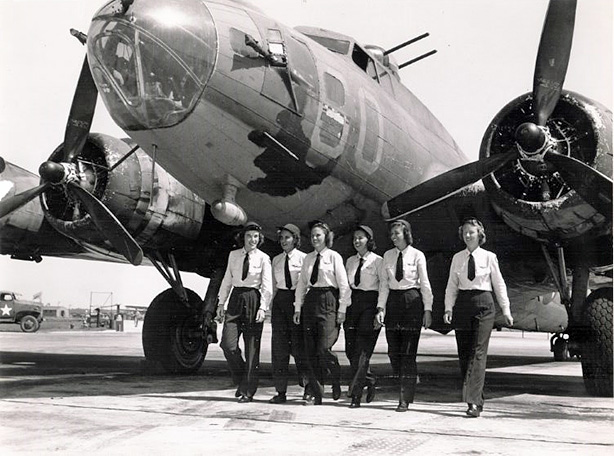
Dawn Seymour, at left, with five other Women Airforce Service Pilots (WASPs) in front of a Boeing B-17 Flying Fortress at Fort Myers, Florida, in 1944. Photo: Provided by Sam Seymour.
Serving her country 'in a very active way':
Dawn Seymour '39 took to the skies during World War II
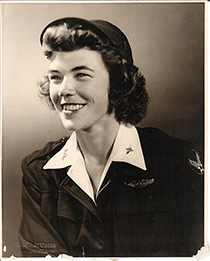
Dawn Seymour '39 as a member of the Women Airforce Service Pilots during World War II. Photo: Provided by Sam Seymour.
When she was a child, Dawn Seymour '39 liked being high in the air.
"I always had a favorite tree to climb," she said recently. "I've always liked to be up above."
Seymour, 97, lives up above Canandaigua Lake in South Bristol, New York, where she can study ripples on the water and clouds in the sky from her home on a high bank. Her memories of being even farther above are still vivid.
Seymour flew planes as a Woman Airforce Service Pilot (WASP) during World War II. Between March 1943 and December 1944, she flew B-17s on training missions in Florida and New Mexico. She has not forgotten the thrill of flying a plane, nor does she want the 1,100 WASPs to be forgotten.
Her own story, which she told on National Public Radio's "The Moth Radio Hour" on Nov. 4, began in 1939 in Ithaca.
She was 22 years old, newly graduated from Cornell's College of Home Economics (now the College of Human Ecology), where she worked as an instructor. One day a professor, Richard Parmenter (Class of 1917), told Seymour, "You can learn to fly."
"I said to him, 'Dr. Dick, I've never been in an airplane,'" Seymour recalled.
Parmenter, a World War I Army pilot, was director of flight research with Ithaca's Civilian Pilot Training Program (CPTP), and he saw a potential pilot in Seymour. He took her up in a yellow Piper Cub from the Ithaca airport. She fell in love with flying.
"We went over the campus, and I said to myself, this is marvelous," she said. "No borders, and it's a boundless view, and I could just go on and on."
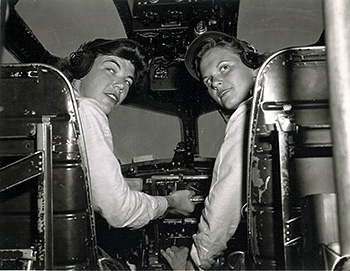
Seymour, left, with her friend and co-pilot Frances Green in the cockpit of a B-17 at Fort Myers, Florida, in 1944. Photo: Provided by Sam Seymour.
Flight training and daily missions
Seymour signed up for the CPTP, a U.S. government program, right away. Although five out of 50 spots in the program were reserved for women, she encountered some resistance. The dean in charge of the ground school did not want women in his program, and even one of Seymour's female professors told her, "You cannot fly." Still, she found a way and was soon granted a private pilot certificate.
Then Pearl Harbor hit in December 1941. Everyone's fighting spirit was up, she said. Seymour supported the war effort locally with the New York State War Council, but what she really wanted to do was fly.
"I wanted to serve my country in a very active way," she said.
Seymour became a WASP. She received military flight training at the all-women training field in Sweetwater, Texas. Next, she did further training at Lockbourne Air Force Base in Columbus, Ohio, where her class of thirteen women pilots shared the base with men completing the same course. She learned to fly the B-17, which became her favorite aircraft.
In 1943 and 1944, Seymour was at Buckingham Air Force Base in Florida, flying daily missions in the B-17 to train gunners.
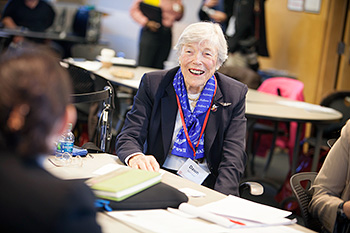
Seymour participates in a presentation and discussion on the best practices and challenges in the recruitment and retention of women veterans in King-Shaw Hall at Cornell Nov. 3. See related Cornell Chronicle story. Photo: University Communications Marketing.
"This is where the gunners would get their first time firing the .50-caliber machine gun on a moving target," she said. "Some of them had never been up in the air, and they were kids -- some of them only 18 or 19 years old."
The gunners had two training flights of four hours each before being assigned to crews in Germany or the Pacific theater. The most difficult aspect of life as a WASP, she said, was the lack of immediate news of the war: "We had rumors, but we did not have news."
Life as a pilot was intense, but she found time for romance. Seymour met Bill Balden, a B-26 pilot, early one morning as both prepared to fly missions from the Florida base. They married in May 1944.
As the war progressed, Seymour was transferred to fly training missions in Roswell, New Mexico. In all, she flew about 700 hours in the B-17.
Then a letter arrived at the base from the U.S. government, announcing the end of the WASP program on Dec. 20, 1944.
"The message we received was, 'Girls, go home, we don't need you anymore,'" Seymour said. "We cleared the base and returned to our new lives."
She returned to be with her husband on the base where they'd met. She found ways to support the war effort until the war ended in 1945, but she missed flying.
Seymour also encountered personal loss just after the war. Her husband was killed in 1946 while flying as a passenger, leaving behind his young wife and their son. Ten years later, she married Mort Seymour. They had four children; Dawn Seymour worked for her family's business, the Rochester-based Rochow Swirl Mixer Company, stepping in as owner after her father died.
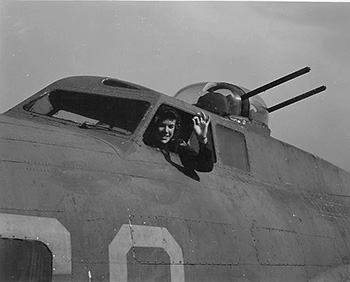
Seymour gestures from the cockpit of a B-17 at Fort Myers, Florida, in 1944. Photo: Provided by Sam Seymour.
'A proud bunch'
About 1,100 women had gone through WASP training. Thirty-eight were killed during the war in accidents during training and missions, yet at the time, WASPs did not have military veteran status -- they were considered civilian volunteers. The WASPs took up collections to bring their comrades' bodies home for burial, and the families were not allowed to put a flag on the coffin or a gold star in the window. Surviving WASPs, a proud bunch, were not even entitled to veterans' medical care as they aged.
In 1977 Congress and the Department of Defense bestowed military veteran status to the WASPs. In 1982, Seymour became president of the WASP organization. In the 1990s, she served as memorial chair, researching and writing the stories of the 38 women who lost their lives for their country during the war.
"People still don't know about the WASPs," she said. Exhibits have been installed in museums and air bases across the country; her dream is a permanent, extensive exhibit in the Smithsonian Institution in Washington, D.C.
"I like to encourage women to try," she said. "Life doesn't come easy."
Seymour retains a muscle memory of flying an aircraft. She remembers squeezing tennis balls to maintain the upper body strength required to fly the B-17. She remembers her first solo night flight vividly.
"It was a velvet night, a winter night," she said. "We're coming in on final -- Lockbourne Air Base, Columbus, Ohio. I'm saying to myself, this little voice said, 'I'm a pilot!'"
For just a moment, she paused with the wonder of what she had become. That feeling of confidence, she said, has helped her through many of the ups and downs in her life.
Then she got back to the task at hand: "I lined up the airplane with the blue lights -- the running lights -- and I said, 'I've got work to do,' and I landed this big, beautiful friend."
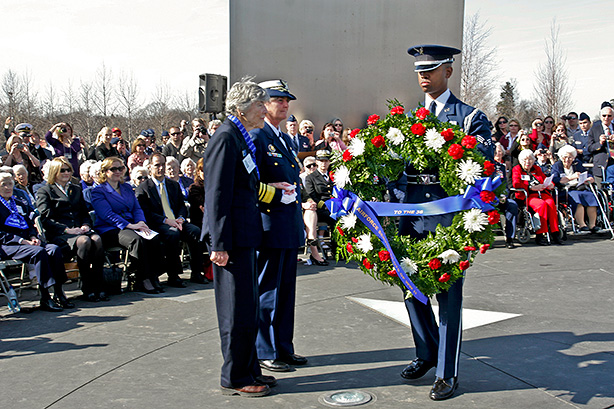
Women who flew with Women Airforce Service Pilots in World War II, including Seymour (standing at left), attend a wreath-laying and remembrance ceremony in their honor at the Air Force Memorial in Arlington, Virginia, in March 2010. The ceremony was part of a two-day event in which all 1,102 women service pilots received the Congressional Gold Medal. Photo: Linda Hosek/U.S. Department of Defense.